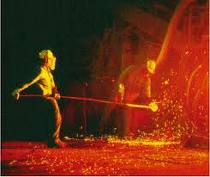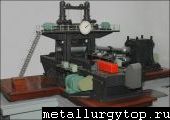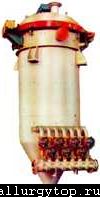The Innovative Makings of Metallurgy
 Human metallurgy's existence or early indications dates back from fifth and sixth millennium BC and was observed in the archaeological locations of Serbia. An example of this include copper axe from 5,500 BC that belongs to the Vincha culture. Other indications of human metallurgy are recovered from the third millennium BC in places like Portugal, Spain, and United Kingdom.
Human metallurgy's existence or early indications dates back from fifth and sixth millennium BC and was observed in the archaeological locations of Serbia. An example of this include copper axe from 5,500 BC that belongs to the Vincha culture. Other indications of human metallurgy are recovered from the third millennium BC in places like Portugal, Spain, and United Kingdom.
Even so, the furthest beginnings cannot be defined distinctly and new breakthroughs are continuous and ongoing. Historical developments in metallurgy when it comes to ferrous can be discovered in a huge diversity of cultures and civilizations in the past. Noteworthy of interest are the many applications, uses, and machines related or involved in metallurgy were probably laid down in ancient China compared to performance of Europeans who also dominated these crafts.
The innovative makings of furnace, cast iron and steel are examples produced from ancient China. However, advanced studies and research hints that Roman technology exceedingly the widely used until now due to its sophistication. This is in particular for mining methods, forging and extraction of metals. An instance was the expertise of hydraulic mining methods well even before Chinese or any other civilizations at that period. Up until the 18th century, the iron works has been restrained by consumer uses. The smelting or extracting of metals through heat such as iron needs huge amounts of expensive charcoal, with the effect that ironworks mostly placed inaccessibly in the center of forests.
In 1709 at Coalbrookdale on the river Severn, an ironmaster named Abraham Darby made a discovery that coke can be utilized in lieu of charcoal when extracting pig iron through heat. During the early phases of the Industrial Revolution, Severn region became the center of iron production in Britain. Few months in 1779, the very first iron bridge built by Abraham Darby over the Severn just downstream from Coalbrookdale has over a hundred feet single span.
The next few years Henry Cort, also an ironmaster with a mill in Hampshire, patented two methods of long–lived importance in the story of metallurgy. One method in 1784 known as puddling is an innovation in a furnace, which agitates the molten iron so that air mixes with it. Oxygen mixes with carbon in the metallic compound that leaves almost pure iron. Pure metal is different with cast iron due to its malleability and not prone to brittleness. This makes the metal capable of hammered and form it is a much more usable metal in industrial processes than cast iron.





Some Uses of the Metallurgical Microscope
 Today, microscopes are made for a particular purpose. For instance, biological microscopes are best in examining living organisms while industrial microscopes have to be employed in a factory's assembly line. The same is true when it comes to the metallurgical microscope.
Today, microscopes are made for a particular purpose. For instance, biological microscopes are best in examining living organisms while industrial microscopes have to be employed in a factory's assembly line. The same is true when it comes to the metallurgical microscope.
Definition
A Metallurgical microscope is primarily used in the industries to observe flat and/or shiny metals and other surfaces. It differs from other types in that it is capable of giving you a closer look at highly polished materials.
Uses
A Metallurgical microscope can be used in a variety of ways. Because of this, buying one would be a worthy investment.
Here are some of the areas where a metallurgical microscope would be of so much help:
Metallurgy – Obviously, this field would benefit from the use of a metallurgical microscope. By using this instrument, you will be able to study and identify metals and other objects through its physical properties and structure.
Archaeometallurgy – this is the study of metal use and production history. Through the use of a metallurgical microscope, you can study a pre–historic metal and know how it is processed and used. This then allows you to have adequate education and experience with regards to this field.
Gemology – This is the very interesting field on precious stones. While a metallurgical microscope is not primarily used for this purpose, it can very well deliver. In gemology, one identifies and evaluates precious stones. Given the proper training and license, a gem appraiser will be able to attach a monetary value to a certain piece of jewelry. Truly, with the use of a metallurgical microscope, one understands why diamonds are more expensive than other gems.
Forensic Metallurgy – This field of study deals with analyzing and investigating structures that have components of metal and which are related to a crime case. In other words, this area helps bring out the inner CSI (Crime Scene Investigator) in you. In this field, you will learn how a series of events would lead to an accident or incident. To compare two samples, a special kind of compound metallurgical microscope has to be used though.
Mineralogy – This is the broader field that includes gemology. In this area, you get to study the chemical as well as the physical properties of the different minerals. By examining minerals under this microscope, you would be able to identify their origin, use and even geographical distribution. You will also be treated with information on certain mineral characteristics such as color, streak, luster, hardness and crystalline structure.
These are only few of the fields of science that can benefit from the use of these microscopes. True, microscopes can be quite expensive and even bulky, but with the many things that they can do, and with the many areas that they can prove to be useful, such a large investment should be all worth it in the end.





«Норникель» увеличил чистую прибыль
 Российская компания «Норильский никель» в I полугодии увеличила чистую прибыль по МСФО в 5,3 раза до 2,345 млрд долларов по сравнению с 439 млн долларов за аналогичный период 2009 года, говорится в ее финотчете. Операционная прибыль выросла в 3,1 раза и составила 2,953 млрд долларов, валовая прибыль — в 2,6 раза до 3,445 млрд долларов.
Российская компания «Норильский никель» в I полугодии увеличила чистую прибыль по МСФО в 5,3 раза до 2,345 млрд долларов по сравнению с 439 млн долларов за аналогичный период 2009 года, говорится в ее финотчете. Операционная прибыль выросла в 3,1 раза и составила 2,953 млрд долларов, валовая прибыль — в 2,6 раза до 3,445 млрд долларов.
За январь–июнь выручка «Норникеля» увеличилась на 68% до 6,837 млрд долларов против 4,078 млрд долларов за I полугодие 2009 года.
Согласно российским стандартам бухгалтерского учета, выручка компании за отчетный период выросла на 44,6% и составила 130,579 млрд рублей.
ОАО "Горно–металлургическая компания «Норильский никель» — крупнейший в мире производитель никеля и палладия, ведущий мировой производитель платины, кобальта, меди и родия. Компания также производит золото, серебро, иридий, осмий, селен, рутений и теллур. Подразделения «Норникеля„ расположены в России, Финляндии, США, Австралии, Ботсване и ЮАР.Российская компания “Норильский никель» в I полугодии увеличила чистую прибыль по МСФО в 5,3 раза до 2,345 млрд долларов по сравнению с 439 млн долларов за аналогичный период 2009 года, говорится в ее финотчете. Операционная прибыль выросла в 3,1 раза и составила 2,953 млрд долларов, валовая прибыль — в 2,6 раза до 3,445 млрд долларов.
За январь–июнь выручка «Норникеля» увеличилась на 68% до 6,837 млрд долларов против 4,078 млрд долларов за I полугодие 2009 года.
Согласно российским стандартам бухгалтерского учета, выручка компании за отчетный период выросла на 44,6% и составила 130,579 млрд рублей.
ОАО "Горно–металлургическая компания «Норильский никель» — крупнейший в мире производитель никеля и палладия, ведущий мировой производитель платины, кобальта, меди и родия. Компания также производит золото, серебро, иридий, осмий, селен, рутений и теллур. Подразделения «Норникеля» расположены в России, Финляндии, США, Австралии, Ботсване и ЮАР.




